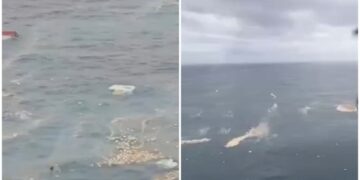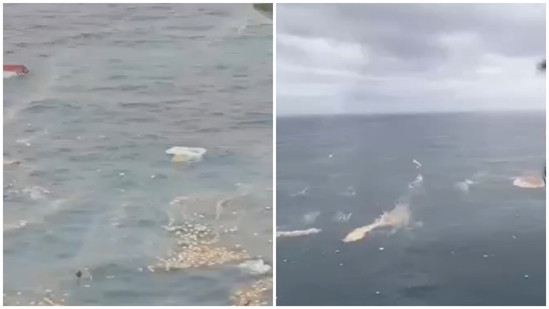On Sunday, the Liberian-flagged container ship MV MSC ELSA 3 capsized and sank approximately 15 nautical miles off the coast of Kerala, near Alappuzha. The vessel was en route from Vizhinjam to Kochi when it went down about 38 nautical miles from shore, carrying a total of 643 containers, including 73 empty ones and 13 containers holding hazardous materials such as calcium carbide — a chemical that poses serious fire risks when in contact with water.
By Monday, more than 100 containers were spotted floating in the sea near the wreck site, causing alarm among authorities and environmental experts. The Indian Coast Guard (ICG) released aerial footage showing a large-scale spill covering an estimated area of 2 by 1 nautical miles, with visible patches of oil spreading across the water’s surface and several containers breaking apart, releasing their contents into the surrounding marine environment.
In response, the ICG deployed the pollution response ship Saksham and sent a Dornier aircraft over the site to conduct aerial assessments and spray Oil Spill Dispersants (OSD) to contain the slick. Due to rough sea conditions with waves reaching 4 to 5 meters, ships were unable to spray dispersants effectively, so aerial spraying was the preferred method.
Kerala State Pollution Control Board (KPCB) Chairperson Sreekala S confirmed that no containers carrying calcium carbide have washed ashore yet, and only a thin oil sheen has been detected in the water so far. However, authorities are closely monitoring the situation and have collected water samples from the affected areas, including Kollam and Alappuzha, where some containers have drifted ashore.
Local officials are prepared for a full-scale coastal cleanup if oil reaches beaches. Contaminated sand will be carefully scooped and transported to Kerala Enviro Infrastructure Limited’s hazardous waste facility in Kochi for safe disposal.
To prevent the oil slick from entering the sensitive Ashtamudi and Vembanad lakes, the KPCB is coordinating with the State Disaster Management Authority to request deployment of boom barriers at critical spillway locations. This is vital to protect these ecologically significant backwaters from contamination.
Regarding the hazardous calcium carbide cargo, experts remain vigilant. If any containers reach land, multiple agencies including the Fire Force and Chemical Explosives Department are ready with established safety protocols to manage the risk of acetylene gas release and potential fires, which require special extinguishing agents like dust or clay powder instead of water.
The Directorate General of Shipping will oversee the recovery of the sunken containers and coordinate cleanup efforts alongside other agencies. A high-level meeting was held to assess all possible environmental and safety scenarios related to the incident.
Maritime advisories have been issued, urging vessels in the region to exercise caution due to floating debris and pollution hazards, as authorities continue their ongoing efforts to manage the aftermath of this significant maritime disaster off Kerala’s coast.








 India
India












